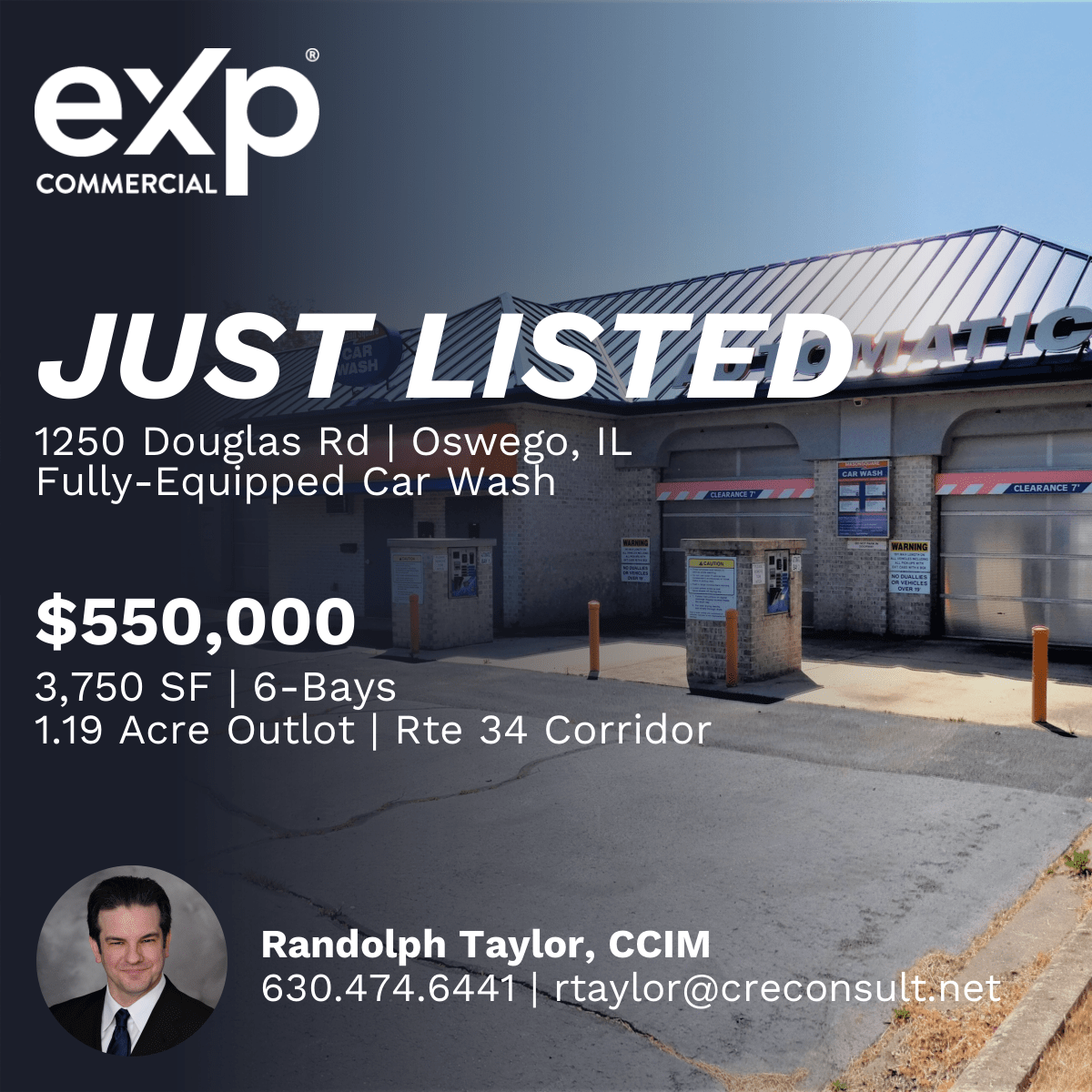1,500–3,673 SF | $26/SF MG
1120 E Ogden Ave., Suite 101, Naperville, IL 60563
Broker: Randolph Taylor, rtaylor@creconsult.net, 630.474.6441
https://www.creconsult.net/retail-office-for-lease-1120-e-ogden-ave-suite-101-naperville-il-60563/

eXp Commercial is one of the fastest-growing national commercial real estate brokerage firms. The Chicago Multifamily Brokerage Division focuses on listing and selling multifamily properties throughout the Chicago Area and Suburbs.


First, what does proforma mean in real estate? In real estate, the word proforma simply means cash flow projection. The word “pro forma” is Latin for “as a matter of form” and it is a term used to describe the document that lays out a cash flow forecast. The real estate proforma is important because it shows a forecast of all sources of income and expenses for a property, as well as a bottom-line cash flow figure.
Sometimes you will see this term written with two words as “pro forma” and other times you will see it written more concisely as “proforma”. Both are commonly used in the commercial real estate industry and have the same meaning.
We’ll go through a more detailed example below, but first let’s start with the basic real estate proforma format. This is often what will be created during a back of the envelope analysis, before moving on to a more detailed projection. A proforma can be completed for a single period of time, such as a year, or over multiple time periods. At a high level, a simple proforma is often structured like this:
Let’s look closer at each of these line items.
Potential Gross Income is the primary potential source of income a property could generate if it were 100% occupied. In practice, this consists of income from contractual leases in place, and if a space is vacant then an estimate for market rent is used.
Vacancy is a deduction that accounts for unoccupied space in the building, and Credit Loss is a deduction for non-payment by tenants. These deductions are commonly expressed as a percentage of Potential Gross Income.
The Effective Gross Income is what’s left over after deducting vacancy and credit loss from Potential Gross Income.
Operating Expenses for a commercial property consist of all expenses required to operate the property. Major categories of expenses include property taxes, insurance, maintenance, janitorial, utilities, management, etc.
The Net Operating Income (NOI) is what’s left over after subtracting out operating expenses from the Effective Gross Income. The Net Operating Income, often abbreviated as NOI, is one of the most widely used metrics for a property.
Other Expenses deducted from the net operating income typically include capital expenditures and loan payments. Capital Expenditures are major expenses required to maintain or add value to the property. These could include the replacement of heating and ventilation systems (HVAC), roof replacement, re-paving a parking lot, etc. Debt Service or loan payments are also deducted from NOI.
Finally, the Before Tax Cash Flow is what’s left over after deducting any additional below NOI expenses such as loan payments or capital expenditures.
A real estate proforma is often completed for the first year of operations for a stabilized property. Stabilized in this sense just means the property has achieved its long term expected occupancy. This proforma can then be used to quickly calculate some back of the envelope return metrics.
Here’s an example of a simple back of the envelope proforma for a single year:
Commercial real estate investors, brokers, lenders, and appraisers often use the net operating income from a simple proforma like this to estimate a property’s market value using the capitalization rate.
A simple proforma can also be completed over multiple years:
A multi-period proforma like this is used to estimate cash flows over the entire holding period and gives a more complete perspective on future investment performance. It allows you to analyze different scenarios such as the best case, worst case, and most likely case. You can also calculate financial ratios such as the cash on cash return, equity multiple, operating expense ratio, etc. over the entire holding period.
An estimate of the future sale proceeds will also need to be calculated in a multi-period proforma. In the commercial real estate industry, future sale proceeds are commonly referred to as the reversion or disposition cash flow, to distinguish from the ongoing operating cash flows of the property.
One way to calculate the disposition price is by applying a cap rate to the net operating income in the final year in the holding period. It is also common to use the NOI for the year after the final year in the holding period, since this will be the first year of NOI for the new buyer. Selling costs such as broker commissions, legal work, etc. can then be estimated and deducted from the future sale price to calculate net sale proceeds.
In the example above, the year 6 NOI is 69,556. We apply our estimated market cap rate of 7% at the time of sale to estimate a future sale price of 993,663. From this, we deduct our estimated selling costs of 6% to arrive at net sale proceeds of 924,107.
Once the future sale proceeds are forecasted along with the operating and investment cash flows, a discounted cash flow analysis can be completed to calculate the Internal Rate of Return (IRR), Net Present Value (NPV), and Modified Internal Rate of Return (MIRR).
Next, let’s add some more context to this discussion and look closer at a more complicated real estate proforma.
Fill out the quick form below and we’ll email you your free real estate proforma template.
A more complicated commercial real estate proforma will follow the same basic structure discussed above, but will include more detail. Before we dive into an example, it is important to note that the way a proforma is presented in practice will often vary from one project to another. This variation could be driven by differences in the property type, complexity of the project, time frame, sophistication of the parties involved, intended audience, and any other unique circumstances.
For example, a multifamily development proforma will not look exactly like an already built hotel proforma because these are different property types in different stages of completion with different sources of income. The same is true for a condominium project with individual units for sale versus a building occupied by a single tenant with a triple net lease.
For most commercial properties, tenants sign long-term leases that spell out in painstaking detail all the income a landlord will receive. These leases contain all the details needed to reliably forecast tenant income for years into the future. The key is to translate this information “lease by lease” to create a more accurate cash flow projection.
As you can imagine, analyzing a property lease by lease is also more complicated and time-consuming. Leases often contain different terms and conditions, with inconsistent requirements for rent, rent increases, or reimbursements. These differences occur because leases are created at different times, often by different landlords, under different market and tax environments, and are negotiated to reflect the specific needs of each party. To make this process faster and easier, many commercial real estate professionals use specialized lease by lease analysis software.
With that said, let’s take a look at what a more detailed proforma looks like for an office, retail, or industrial property:
A more complicated proforma like this can be completed for a single year or over multiple years, and is often prepared on a monthly basis. You’ll notice these line items are similar to the simple proforma structure discussed above, but include some extra detail. Let’s take a closer look.
To understand how to read a proforma like this, let’s discuss each of these line items.
In this article, we defined the real estate proforma, discussed the basic structure of a simple real estate proforma, looked at an example of a single year proforma and also a multi-year proforma, and then walked through a more complicated example of a lease by lease commercial real estate forecast.
Source: The Real Estate Proforma: A Beginner’s Guide
https://www.creconsult.net/market-trends/the-real-estate-proforma-a-beginners-guide/

Valuing commercial property is an important step in every commercial real estate transaction. This post will demystify the commercial property valuation process and walk you through some common valuation techniques used in the commercial real estate industry.
Before we dive into understanding commercial property valuation, let’s take a step back and ask a more philosophical question. What is value? Is commercial property valuation something set in stone, or is it more or less in the eye of the beholder? The answer is a little bit of both. On the one hand, valuation is not 100% set in stone, which is often why commercial property sales requires a negotiation period that can often last several weeks or months.
However, there is a mathematical way to arrive at a reasonable value range, based on the cash flows of the property. In finance, this is known as intrinsic value, and because owners of commercial property are typically investors, they will view their purchase of commercial property rationally. However, with that said, there is a component to value that is always in the eye of the beholder. When value becomes disconnected from the underlying fundamentals, it can often be for reasons that supersede cash flow, such as ego, sentimental value, or speculation about the future.
The first task in commercial property valuation is to build a real estate proforma. A real estate proforma is simply a projection of cash flows for a commercial property over your desired holding period. Once you have an accurate cash flow projection, you can then determine value using some common investment ratios, and ultimately a discounted cash flow analysis.
If you need some assistance with this, our web-based real estate analysis software can help you build a real estate proforma, value commercial property, and generate presentation quality reports.
Once a real estate proforma is constructed, most investors begin analyzing commercial properties by looking at some common measures of investment performance. These indicators are a quick and dirty way of determining whether or not to take a closer look at a potential acquisition.
Some of these simple measures of investment performance include the cap rate, cash on cash return, and gross rent multiplier. For a more in depth explanation of these ratios, check out our article on common real estate formulas you should know.
These simple ratios are fine for quickly assessing a property, but it’s important to understand that they have many shortcomings when it comes to valuation. The problem with just using simple ratios to value a property is that they don’t take into account changes in cash flow over time, nor do they account for risk and the time value of money.
Only a multi-period discounted cash flow analysis will help you account for variations in income due to lease expirations, reimbursements, abatement, rental rate and expense escalations, and other drivers of net operating income. Additionally, a discounted cash flow analysis will take into account an investor’s desired rate of return, unlike simpler measures of value.
Grasping the mechanics of a discounted cash flow analysis can be challenging at first, but it’s essential in understanding any commercial real estate transaction. To get more of a gut feel for what a discounted cash flow analysis is telling you and why it’s important, check out the Intuition Behind IRR and NPV.
To jump start your commercial property valuation, give our commercial property valuation software a spin, free for 30 days!
Source: How to Value Commercial Property
https://www.creconsult.net/market-trends/how-to-value-commercial-property/

Average of the top competitive rates from eXp Commercial's National Capital Markets Partner CommLoan from a database of 700+ commercial lenders as of 731/23
*Rates are provided for comparison purposes only. Actual rates are dependent on property and sponsor.
https://www.creconsult.net/market-trends/commercial-real-estate-financing-rate-snapshot-july-31st-2023/
Commercial real estate can be broken down into several different categories. At a high level, when people think of different types of commercial real estate, they typically think about shopping centers, office buildings, or warehouses. But the commercial real estate industry is much more precise when it comes to defining property types. Below is a list of different types of commercial real estate with a description of how each category is typically defined.
Classification. Office buildings are usually loosely grouped into one of three categories: Class A, Class B, or Class C. These classifications are all relative and largely depend on context. Class A buildings are considered the best of the best in terms of construction and location. Class B properties might have high quality construction, but with a less desirable location. And Class C is basically everything else.
Central Business District (CBD). Office buildings located in the central business district are in the heart of a city. In larger cities like Chicago or New York, and in some medium sized cities like Orlando or Jacksonville, these buildings would include highrises found in downtown areas.
Suburban office buildings. This classification of office space generally includes midrise structures of 80,000-400,000 square feet located outside of a city center. Cities will also often have suburban office parks which assemble several different midrise buildings into a campus-like setting.
Heavy manufacturing. This category of industrial property is really a special use category that most large manufacturer’s would fall under. These types of properties are heavily customized with machinery for the end user, and usually require substantial renovation to re-purpose for another tenant.
Light Assembly. These structures are much simpler than the above heavy manufacturing properties, and usually can be easily reconfigured. Typical uses include storage, product assembly, and office space.
Flex warehouse. Flex space is industrial property that can be easily converted and normally includes a mix of both industrial and office space.
Bulk Warehouse. These properties are very large, normally in the range of 50,000-1,000,000 square feet. Often these properties are used for regional distribution of products and require easy access by trucks entering and exiting highway systems.
Strip Center. Strip centers are smaller retail properties that may or may not contain anchor tenants. An anchor tenant is simply a larger retail tenant which usually serves to draw customers into the property. Examples of anchor tenants are Wal-Mart, Publix, or Home Depot. Strip centers typical contain a mix of small retail stores like Chinese restaurants, dry cleaners, nail salons, etc.
Community Retail Center. Community retail centers are normally in the range of 150,000-350,000 square feet. Multiple anchors occupy community centers, such as grocery stores and drug stores. Additionally, it is common to find one or more restaurants located in a community retail center.
Power Center. A power center generally has several smaller, inline retail stores, but is distinguished by the presence of a few major box retailers, such as Wal-Mart, Lowes, Staples, Best Buy, etc. Each big box retailer usually occupies between 30,000-200,000 square feet, and these retail centers typically contain several out parcels.
Regional Mall. Malls range from 400,000-2,000,000 square feet and generally have a handful of anchor tenants such as department stores or big box retailers like Barnes & Noble or Best Buy.
Out parcel. Most larger retail centers contain one or more out parcels, which are parcels of land set aside for individual tenants such as fast-food restaurants or banks.
Garden Apartments. Suburban garden apartments started popping up in the 1960s and 1970s, as young people moved from urban centers to the suburbs. Garden apartments are typically 3-4 stories with 50-400 units, no elevators, and surface parking.
Midrise Apartments. These properties are usually 5-9 stories, with between 30-110 units, and elevator service. These are often constructed in urban infill locations.
Highrise Apartments Highrise apartments are found in larger markets, usually have 100+ units, and are professionally managed.
Full service hotels. Full service hotels are usually located in central business districts or tourist areas, and include the big name flags like Four Seasons, Marriott, or Ritz Carlton.
Limited service hotels. Hotels in the limited service category are usually boutique properties. These hotels are smaller and don’t normally provide amenities such as room service, on-site restaurants, or convention space.
Extended stay hotels. These hotels have larger rooms, small kitchens, and are designed for people staying a week or more.
Greenfield Land. Greenfield land refers to undeveloperd land such as a farm or pasture.
Infill Land. Infill land is located in a city has has usually already been developed, but is now vacant.
Brownfield Land. Brownfields are parcels of land previously used for industrial or commercial purposes, but are now available for re-use. These properties are generally environmentally impaired.
The above categories of real estate cover the major types of commercial real estate. However, there are plenty of other types of commercial real estate that investors construct and own. Examples of special purpose commercial real estate include self-storage, car washes, theme parks, bowling alleys, marinas, theaters, funeral homes, community centers, nursing homes, and churches.
Source: Types of Commercial Real Estate
https://www.creconsult.net/market-trends/types-of-commercial-real-estate/
🏡 SOUTHEAST DUPAGE MULTIFAMILY: Q4 2025 MARKET SNAPSHOT Quiet stability, high occupancy, and buyers circling for suburban product. In towns...